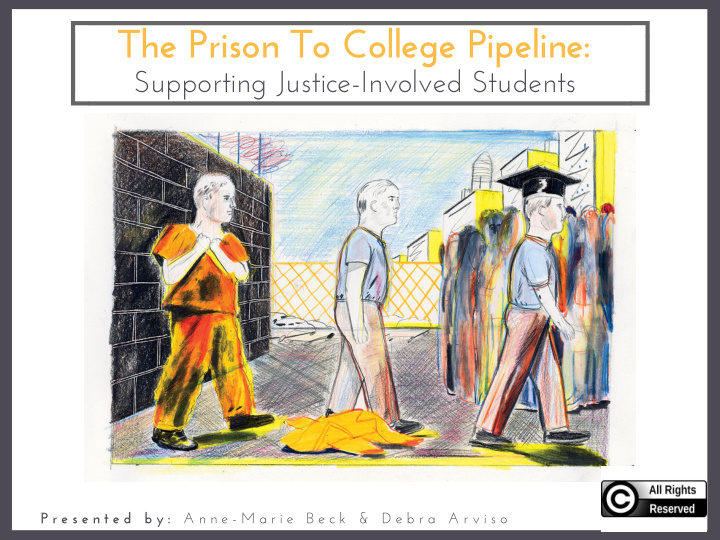



The Prison To College Pipeline: Supporting Justice-Involved Students P r e s e n t e d b y : A n n e - M a r i e B e c k & D e b r a A r v i s o
Current U.S. Prison Population = over 2 million Source: World Prison Brief
Compared to the rest of the world..
Population of inmates in California: 83,000 Several million Californians currently living with criminal convictions Approximately 400,000 Californians living under supervision / parole per year Nearly 90% of people under supervision are within 15 miles of public college campus Sources: World Prison Brief & Degrees of Freedom: Expanding Opportunities for Currently and Formerly Incarcerated Californians
Recidivism: a tendency to relapse into a previous condition or mode of behavior; especially: relapse into criminal behavior California's rate of recidivism = one of the highest in the country: 58% Source: Merriam-Webster Dictionary & Pew Charitable Trust: "State of Recidivism The Revolving Door of America's Prisons" 2011
The Power of an Education Meta-Analysis by the RAND Corp: Individuals who participate in college programs while in custody = 51% lower odds of recidivating Source: Davis LM, Bozick R, Steele JL, Saunders, J., Miles, J. (2013)
...and the Power of Employment Employment = major predictor of recidivism (regardless of criminal classification) Source: Nally, M., Lockwood, S., Ho, T., & Knutson, K. (2009)
Trauma & The Incarcerated Population 2009 Study of 4,000 inmates: 56% of men 54% of women Reported physical abuse in childhood Source: Wolff, N., Shi, J., & Siegel, J.A. (2009)
Definition of Trauma An event that is experienced as physically or emotionally harmful or life threatening and that has lasting adverse effects on the individual’s functioning and well-being. Source: Substance Abuse and Mental Health Service Administration (SAMSHA)
Trauma During Incarceration Individuals can be traumatized while incarcerated as well. 1998 study: 1/10 (of 581 inmates) reported being physically assaulted within 6 months of interview Source: Wooldridge, J. D. (1998)
Other Groups At Risk For Trauma • Foster Youth • Refugee students • LGBTQ students • Veterans • American Indian/Alaska Native students
Trauma In College Students What you might see: • Difficulty focusing and recalling • Withdrawal and isolation • Missing a lot of classes • Fear of taking risks Source: Hoch, A., Stewart, D., Webb, K., & Wyandt-Hiebert, M. A. (2015, May).
Trauma Informed Approach: 3 Rs A program, organization, or system that is trauma-informed: • Realizes the impact of trauma and understands paths for recovery • Recognizes the signs of trauma in students, staff, and others involved with the system • Responds by integrating knowledge about trauma into • Policies • Procedures • Practices Goal: Resist Retraumatization Source: Hoch, A., Stewart, D., Webb, K., & Wyandt-Hiebert, M. A. (2015, May).
Safety & Trustworthiness • Are first contacts welcoming, respectful, and engaging? • How safe is the building or environment? • Is information about tasks and procedures clear? • Are roles and professional boundaries defined? Source: Hoch, A., Stewart, D., Webb, K., & Wyandt-Hiebert, M. A. (2015, May).
Collaboration & Empowerment • Are trauma survivors on an advisory board that evaluates services? • Are opportunities to work with faculty advertised? • Are each student’s strengths and skills recognized? • Are students encouraged to advocate for themselves Source: Hoch, A., Stewart, D., Webb, K., & Wyandt-Hiebert, M. A. (2015, May).
Working With Trauma-Affected Individuals • Normalize and validate their feelings and experiences • Empower them to better manage their current lives • Check in & express concern for emotional safety Source: Source: Knight, C . (2015); Carello, J., & Butler, L. D. (2014); Downey, L. (2013); Health Federation of Philadelphia (2010); Wolpow, R., Johnson, M. M., Hertel, R., & Kincaid, S. O. (2009)
Connecting the Dots: Warm Hand-Off • Identify trauma informed allies on campus • Identify allies at off campus service providers: * Probation * Department of Mental Health * Workforce Development * Department of Rehabilitation * CSU & UC programs * Housing Getting the run-around, encountering unfriendly staff, or getting unreliable information can be re-traumatizing
Possible Career Development Challenges Limited awareness of skills, interests, values Criminal background serves as barrier to employment Lack of qualifications / low employment prior to and after incarceration Low educational attainment Housing, food, and transportation Sources: Shivy et. al, 2007; Lebel, 2012; Unruh, Gau, & Waintrup, 2009
Possible Career Development Challenges Interpersonal difficulties Re-working identity Substance abuse disorder Mental or physical disability Negative thinking / Dysfunctional career thoughts Sources: Laux et. al, 2011; Lynch & Sabol, 2001; Haney, 2006; Travis et. al, 2001; Shivy et. al, 2007
Root & Rebound: Reentry Advocates Provide several different guides (also: My Education, My Freedom & Employers' Fair Chance Hiring Toolkit) Provide trainings on how to use their resources Have a free legal hotline: 510-279-4662
Career Theories to Consider Positive Psychology / Strengths-Based Psychology Narrative / Storied Approach Planned Happenstance Cognitive Therapy
"It is never too late to be what you might have been." - George Elliot
Recommend
More recommend